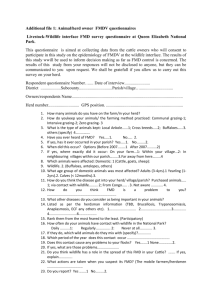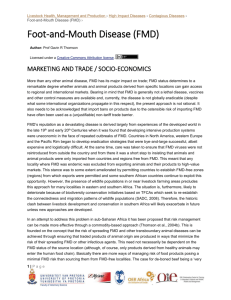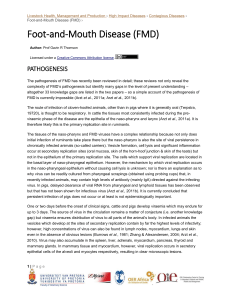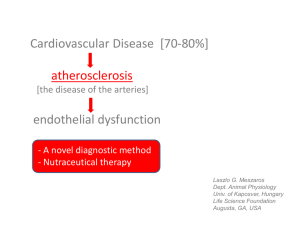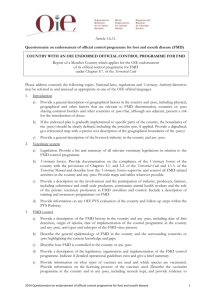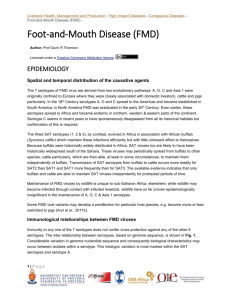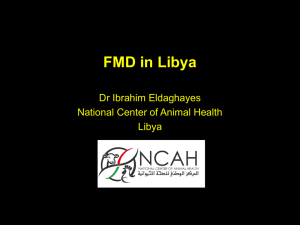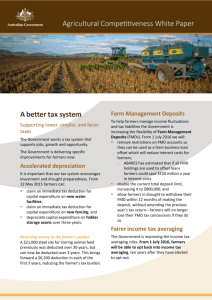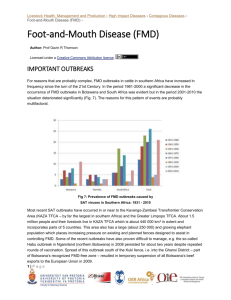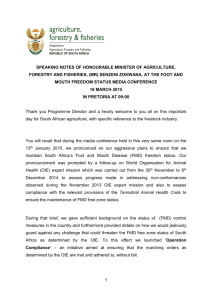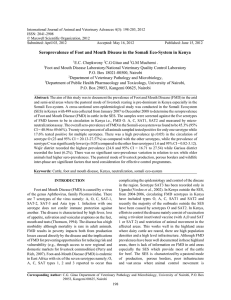fmd_fs
advertisement
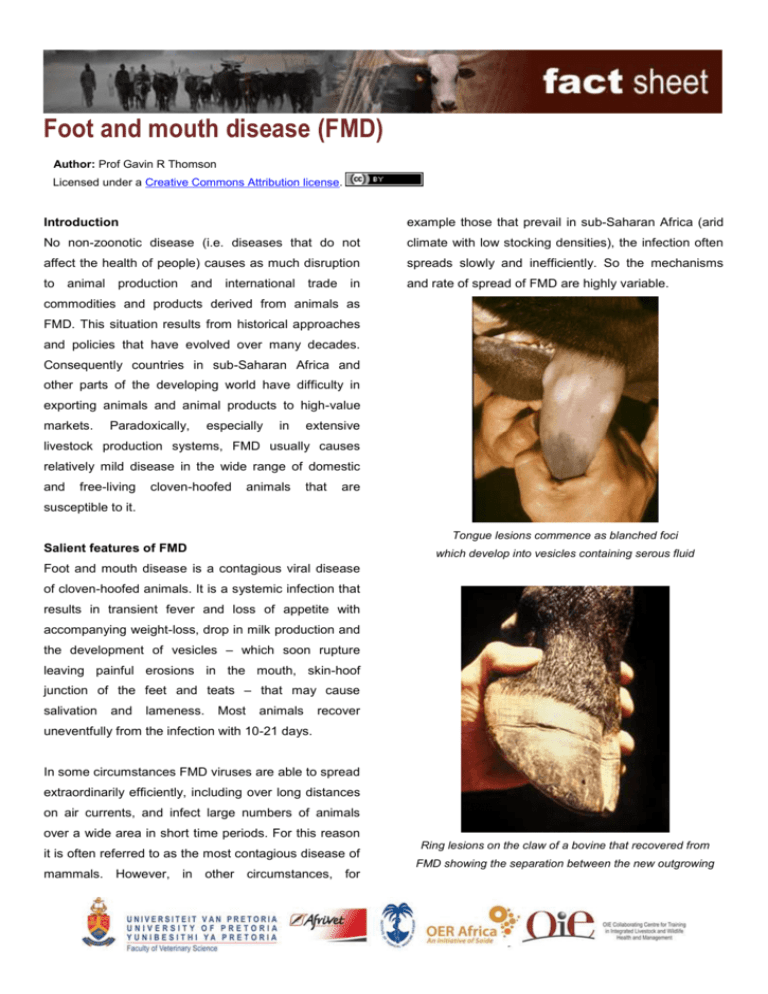
Foot and mouth disease (FMD) Author: Prof Gavin R Thomson Licensed under a Creative Commons Attribution license. Introduction example those that prevail in sub-Saharan Africa (arid No non-zoonotic disease (i.e. diseases that do not climate with low stocking densities), the infection often affect the health of people) causes as much disruption spreads slowly and inefficiently. So the mechanisms to animal production and international trade in and rate of spread of FMD are highly variable. commodities and products derived from animals as FMD. This situation results from historical approaches and policies that have evolved over many decades. Consequently countries in sub-Saharan Africa and other parts of the developing world have difficulty in exporting animals and animal products to high-value markets. Paradoxically, especially in extensive livestock production systems, FMD usually causes relatively mild disease in the wide range of domestic and free-living cloven-hoofed animals that are susceptible to it. Tongue lesions commence as blanched foci Salient features of FMD which develop into vesicles containing serous fluid Foot and mouth disease is a contagious viral disease of cloven-hoofed animals. It is a systemic infection that results in transient fever and loss of appetite with accompanying weight-loss, drop in milk production and the development of vesicles ‒ which soon rupture leaving painful erosions in the mouth, skin-hoof junction of the feet and teats ‒ that may cause salivation and lameness. Most animals recover uneventfully from the infection with 10-21 days. In some circumstances FMD viruses are able to spread extraordinarily efficiently, including over long distances on air currents, and infect large numbers of animals over a wide area in short time periods. For this reason it is often referred to as the most contagious disease of mammals. However, in other circumstances, for Ring lesions on the claw of a bovine that recovered from FMD showing the separation between the new outgrowing tissue and the horn of the hoof that were present distal to the coronet prior to lesion development Some ruminants may retain the infection in the oropharynx for weeks to months following clinical Viruses that cause FMD are classified within the genus recovery. However, so far only African buffalo have Aphthovirus and comprise a constantly evolving quasi- been shown to be capable of so-called carrier species that is divisible into 7 serotypes named A, O, transmission. C, Asia 1, SAT1, SAT2 and SAT3. The SAT serotypes and the 4 others form two distinct sub-groups. The Prevention and control currently available evidence indicates that the SAT Because FMD is a contagious disease, methods of serotypes evolved in sub-Saharan Africa in association control are based on prevention of contact between with African buffalo while the other 4 evolved in infected and susceptible animal populations and Eurasia, probably in association with livestock. exposure of susceptible animals to fomites and other sources of indirect exposure. Vaccination can also be In eastern and southern Africa, unlike the rest of the an effective way of preventing infection from spreading world, wildlife populations (buffalo primarily) maintain to susceptible populations but the diversity of the viral SAT serotypes of FMD virus, i.e. provide a constant population (i.e. intra-typic variation) and the fact that reservoir of infection. For that reason the epidemiology the currently used inactivated vaccines induce only of FMD is more complicated in these regions and short-term protection, complicates achievement of the results in conflict between livestock development and high levels of herd immunity required to manage FMD wildlife conservation policies. effectively in domestic livestock. Where does FMD occur? In southern Africa extensive fencing systems have SAT serotypes are still confined to Africa while the traditionally been used to prevent contact between other serotypes occur widely in Africa, Asia, South infected and FMD-free animal populations. These America, parts of central/eastern Europe and the fencing systems sometimes divide ecosystems with Middle East. Eradication of FMD has been achieved in unfortunate ecological impacts. North America, most of Europe, parts of the Pacific Rim and Oceania. In sub-Saharan Africa, SAT1, SAT2, A A ‘Progressive Control Pathway for FMD Control’ (sic: and O serotypes are widely prevalent; infections so-called PCP-FMD) has been accepted by the OIE caused by C are currently rare, as is the case for SAT3 (World Organisation for Animal Health) and FAO (Food except in buffalo populations. Asia 1 infection has & never been recorded in Africa. recommended way forward for the eventual global Agriculture Organisation of the UN) as the eradication of FMD. However, the proposed pathway What triggers an outbreak of FMD? creates a significant problem for southern and eastern Because FMD is contagious the infection is usually Africa because it takes no account of the wildlife precipitated by close contact between susceptible and problem and clashes in approach to rural development acutely infected animals. Another common method of between livestock interests and those of effective spread occurs where scraps of meat from infected wildlife (bio-diversity) conservation. animals are fed to pigs through swill-feeding. Pigs excrete large quantities of virus and especially on large Find out more piggeries may become a potent source of infection for The CPD module on FMD provides a detailed account other susceptible animals. of the disease and the viruses that cause it with emphasis on the way the disease commonly behaves in southern Africa, i.e. its epidemiology. Detail is therefore provided on the role of wildlife in the maintenance and spread of the disease. Other aspects covered by the module are the pathogenesis of FMD, its diagnosis and differential diagnosis, including clinical signs and pathology, and methods for controlling the disease. The module concludes with a section on the effect of FMD on trade in animals and animal products, i.e. the area in which this disease has its greatest impact.
